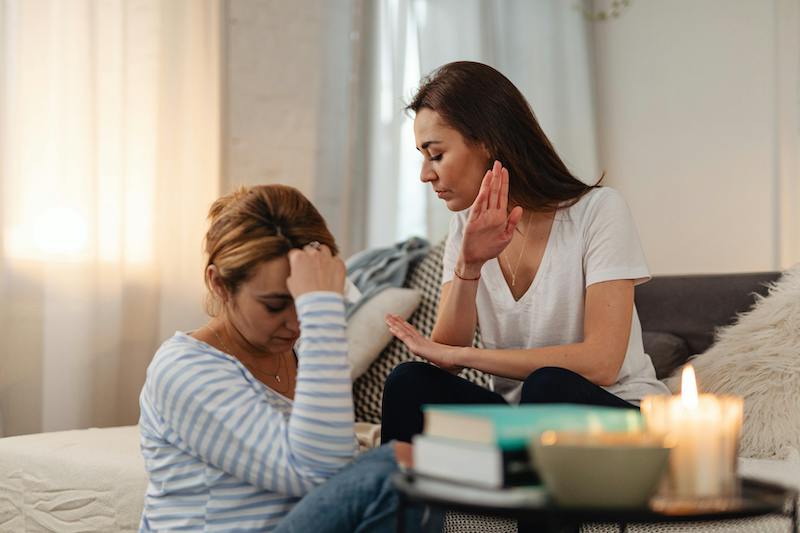Somatic Experiencing for couples offers a unique path to healing and connection. Every couple’s journey looks different, and healing happens in the little moments—one layer, one breath, one step at a time, and sometimes the most profound healing occurs in the space between two people.
The second half of my life, starting in my early 30s, has been healing the nervous system I ignored in my young adult life. This journey has deeply influenced how I understand relationships and why I now bring Somatic Experiencing to couples in my practice.
I’m currently in the first year of Somatic Experiencing (SE) training, a somatic modality for healing trauma. Peter Levine, the founder of this modality, observed that animals in nature rarely get traumatized. He says this is because they can complete the trauma/fear response in their bodies at the moment it happens. An animal in a fear response will shake, take a long, deep breath, and return to the present moment with the fear discharged from their body. When practicing Somatic Experiencing with couples, we can learn from this natural wisdom—how to move through activation together and return to safety in each other’s presence.
SE is a bottom-up modality that starts with the body rather than the mind, as in talk therapy. It involves mindfulness of the body, tracking sensations, and learning to stay with both pleasant and unpleasant sensations to move through stuck trauma. For couples, this awareness becomes a powerful tool for understanding our responses and how we affect and are affected by our partner’s nervous system.
Trauma that is stored in the human body is called Bound Survival Energy. In relationships, this energy can manifest in our reactions to our partner, our capacity for intimacy, and our ability to stay present during challenging moments.
Layer 1: The Trauma Vortex in Relationships
One of the core concepts of SE is the trauma vortex—the pull to relive or stay in trauma responses, which can feel familiar or even safe because they’ve become encoded in our bodies. This vortex can manifest as recurring patterns of conflict, withdrawal, or emotional disconnection in relationships. The trauma vortex keeps us trapped in fear, anchored in the past, and resistant to fully committing to the healing journey together.
The way out of the trauma vortex is through the counter-trauma vortex: orienting to the present moment and noticing what feels okay right now. For couples, this might be feeling the warmth of your partner’s hand, sharing a gentle smile, or simply breathing together. These moments of connection create new pathways of safety in the relationship.
In SE, we use resources to help anchor us in safety. For couples, resources can be individual and shared—like a favorite memory together, a special place you love, or a ritual you’ve created. These resources guide you back to the present and remind you that you’re safe together.
Layer 2: Reconnecting Bodies and Hearts
Since trauma lives in the autonomic nervous system—governed by the reptilian brain—Somatic Experiencing helps bridge the gap between the survival brain and the neocortex, where regulation and awareness reside. For couples, this integration is crucial for moving beyond reactive patterns and into conscious connection.
As you read the next paragraph with your partner, I invite you both to notice the sensations in your bodies, in your hearts, to see how each sentence impacts you individually and as a couple.
In practice, somatic experiencing for couples begin with simple but powerful awareness exercises. You might start by feeling your feet making contact with the ground while sitting near each other, noticing the subtle energy between you. A key practice is ‘orienting’ together – slowly scanning the room until something naturally draws your attention, creating a shared experience of safety and presence. These seemingly simple exercises help rebuild your connection to your body and your capacity to co-regulate with your partner. Coupled with traditional couples coaching, these embodied practices give your nervous systems concrete experiences of safety and presence together.
This connection deepened when I started working with a Somatic Experiencing practitioner a few years ago. Her presence allowed me to slow down and feel my body, teaching me skills I now bring to my work with couples. I’ve learned to track my nervous system and be attuned to the subtle dynamics between partners.
SE gave me the space to feel what was happening inside me fully. It encouraged me to linger in moments of joy—a smile, a sigh of relief, a deep breath—helping me imprint these sensations in my body.
Layer 3: Resourcing the Nervous System
Resourcing is also about what not to do. I had a major epiphany about this when I moved from NYC to San Francisco and finally had access to nature and hiking. But the biggest shift for my nervous system came when I moved to Sonoma.
I stopped being pulled by the wonderful invitations of FOMO available in any city and learned to choose nature as an intention for my nervous system. What took me so long?
I felt a profound exhale every time I drove out of the city. In Sonoma, that feeling became my norm. Tasks that had felt enormous in the city—like finding parking or going to the bank—became easy.
For the first time, I didn’t have to watch my back as a woman walking alone constantly, and I realized how much the city had drained my nervous system as much as inspired directions in my life.
As I’ve healed, I’ve become more aware of how stimuli affect me and can choose my day with this intention as a priority. I spend time in nature, with my dogs, and I value this above anything else.
Resourcing my nervous system has been a major contribution towards healing and informs how I support couples in their journey together.
Layer 4: Healing in Layers
Healing trauma isn’t a single path or quick fix, especially in relationships. It’s an ecosystem of tools and practices supporting individual and couple healing. Through my healing journey and work with couples, I’ve witnessed how peeling back the layers—letting go of fear stored in our bodies, learning to resource ourselves in the present moment, and allowing joy to imprint alongside the pain—creates space for deeper connection.
Somatic Experiencing has taught me that healing is about noticing what’s happening in our bodies, lingering in the good, and connecting with the present moment.
Somatic Experiencing for Couples: Invitation to Work Together
If this resonates with you and your partner, I’d love to support you. My approach combines traditional couples coaching with Somatic Experiencing for couples, creating a unique blend that addresses relationship dynamics and nervous system regulation. As I continue my SE training, I’m offering sessions for couples who might benefit from this work. Together, we can explore tools to ground, reconnect with your bodies, and find ease in the present moment as a couple.
Somatic Experiencing for couples is particularly suited for those curious about their inner landscape and ready to explore healing at their own pace. While relationship challenges may be part of what brings you here, our focus is less on problem-solving and more on building a compassionate, regulated relationship with yourselves and each other.
I work best with developmental and attachment-related challenges rather than recent acute trauma or complex PTSD.
Details:
- Sessions are offered on a sliding scale.
- To learn more or schedule a couple’s consult, use this link here.
This is an opportunity to explore a somatic approach to healing together in a safe and supportive space. I’d be honored to support you both on your journey. Feel free to send me a message if you have any questions.


